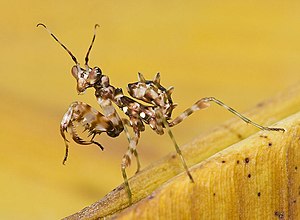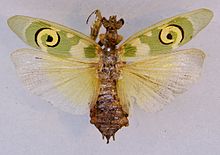West African mantis
| West African mantis | ||||||||||||
|---|---|---|---|---|---|---|---|---|---|---|---|---|

West African mantid nymph |
||||||||||||
| Systematics | ||||||||||||
|
||||||||||||
| Scientific name | ||||||||||||
| Pseudocreobotra ocellata | ||||||||||||
| ( Beauvois , 1805) |

The West African Mantis ( Pseudocreobotra ocellata ) or Augenfleckenmantis is a kind of order of Mantis (Mantodea). It occurs in meadows and on shrubs in West and South Africa. The species was scientifically described for the first time in 1805 by Palisot De Beauvois . Like the related species Pseudocreobotra wahlbergii , it is also called the African flower mantis .
features
The most striking features of the West African mantis are the outgrowths on the body and the colorful spiral-shaped "eye motifs" on the wings of the adult animals. Both of these features serve to camouflage the fishing insect on flowers. Adult animals are about 30 mm tall. Body size is one of the most important features when distinguishing between the West African mantis and the approximately 10 mm larger African mantis. In addition, the African mantis' eye spots are yellow-orange, while those of the West African mantis are lemon yellow. The body is slim and the basic color of the body varies, mostly yellow and green stripes appear next to the white or pinkish-white basic color. Because of their colorful appearance, the praying mantises are often kept and bred in terrariums.
Sex discrimination
The female specimens of the West African mantis are 32 mm long, while the males can only reach a body length of about 25 mm. The male body has six appendages of equal length on the abdomen. The female has only five of these appendages. The male's wings are longer and wider than his abdomen, making them more agile when flying. In the females, the narrower wings protrude over the abdomen. Therefore, female specimens are only capable of short flights. In terms of behavior, females are more aggressive than males.
Reproduction and development
After the imaginal molt, it takes 10 days for the males to be ready to mate, for females it takes 14 days to reach sexual maturity. As soon as a pair has been found, the male climbs on top of the female and copulation lasts 6 to 14 hours. It can happen that the male is already eaten by the female before copulation. After fertilization, it takes about 7 days for the first egg to be laid. This is followed by further egg-laying at intervals of 7 to 14 days. The eggs are laid in so-called oothecae, which can be glued to various substrates. A total of up to 8.5 cm large ooths are built, each filled with around 60 eggs. The larvae hatch after 4 to 6 weeks and mimic the appearance of ants with their glossy black color. They lose this color after the second molt. Overall, female animals have a life expectancy of 9 months and they molt up to 7 times during their lifetime. Males, on the other hand, only live 6 months and molt 6 times.
distribution
The main distribution area of the West African mantis are the West and South African countries: Angola , Burkina Faso , Ghana , Guinea , Cameroon , Kenya , Liberia , Congo , Mozambique , Nigeria , Senegal , Sierra Leone , Tanzania , Uganda , Togo and Kampala . They mainly live in humid areas and can be found on shrubs and flowers.
nutrition
The West African mantis lies in wait for its victims on flowers. Their prey includes flies, crickets, cockroaches and house crickets. If there is not enough food, cannibalism can occur immediately after hatching .
attitude
Female animals should be kept alone in a terrarium because of their aggressiveness. A size of 15 × 15 × 20 cm is sufficient for such a single terrarium. Larvae and male specimens can be kept in groups of five in 30 × 30 × 50 cm terrariums. A fluorescent tube or other heat-radiating lighting means can be used as the light source. The lighting should be 12 hours a day. The temperature should be 26–35 ° C during the day and not below 20 ° C at night. The humidity should be a little lower during the day than at night. Climbing branches, twigs, grasses, flowers or various plants can be used to set up the terrarium. In group housing, sufficient feeding must be ensured at all times.
literature
- Reinhard Ehrmann: Mantodea : women praying to God in the world . Natur und Tier-Verlag, 2002
Web links
- Pseudocreobotra ocellata . ( Memento from April 5, 2012 in the Internet Archive ) Swissmantis.ch
- dahmstierleben.de. Retrieved March 16, 2018
- terra-typica.ch accessed December 17, 2011
- mantiden.npage.de accessed December 26, 2011